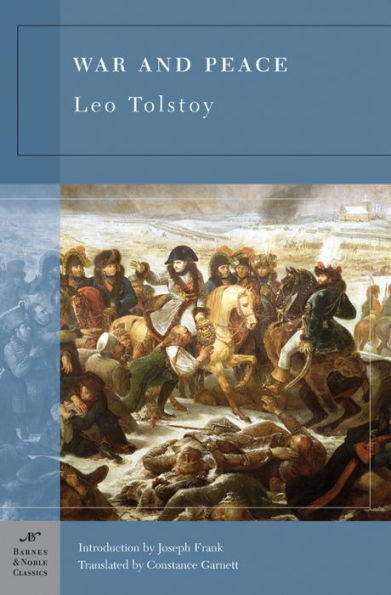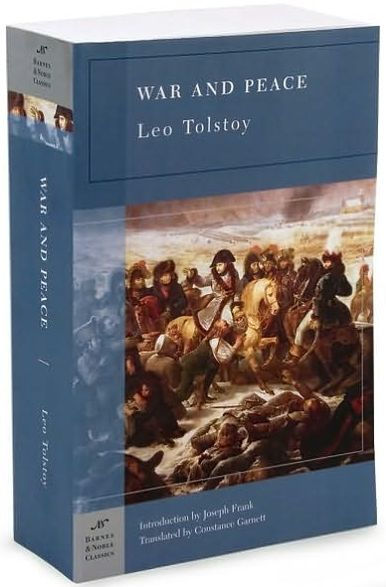War and Peace, by Leo Tolstoy, is part of the Barnes & Noble Classics series, which offers quality editions at affordable prices to the student and the general reader, including new scholarship, thoughtful design, and pages of carefully crafted extras. Here are some of the remarkable features of Barnes & Noble Classics:
The most famous—and perhaps greatest—novel of all time, Tolstoy’s War and Peace tells the story of five families struggling for survival during Napoleon’s invasion of Russia.
Among its many unforgettable characters is Prince Andrey Bolkonsky, a proud, dashing man who, despising the artifice of high society, joins the army to achieve glory. Badly wounded at Austerlitz, he begins to discover the emptiness of everything to which he has devoted himself. His death scene is considered one of the greatest passages in Russian literature.
The novel's other hero, the bumbling Pierre Bezukhov, tries to find meaning in life through a series of philosophical systems that promise to resolve all questions. He at last discovers the Tolstoyan truth that wisdom is to be found not in systems but in the ordinary processes of daily life, especially in his marriage to the novel's most memorable heroine, Natasha.
Both an intimate study of individual passions and an epic history of Russia and its people, War and Peace is nothing more or less than a complete portrait of human existence.
Joseph Frank is Professor Emeritus of Comparative Literature at Princeton University and Professor Emeritus of Comparative Literature and Slavic Languages and Literature at Stanford University. He is the author of a five-volume study of Dostoevsky’s life and work.
War and Peace, by Leo Tolstoy, is part of the Barnes & Noble Classics series, which offers quality editions at affordable prices to the student and the general reader, including new scholarship, thoughtful design, and pages of carefully crafted extras. Here are some of the remarkable features of Barnes & Noble Classics:
The most famous—and perhaps greatest—novel of all time, Tolstoy’s War and Peace tells the story of five families struggling for survival during Napoleon’s invasion of Russia.
Among its many unforgettable characters is Prince Andrey Bolkonsky, a proud, dashing man who, despising the artifice of high society, joins the army to achieve glory. Badly wounded at Austerlitz, he begins to discover the emptiness of everything to which he has devoted himself. His death scene is considered one of the greatest passages in Russian literature.
The novel's other hero, the bumbling Pierre Bezukhov, tries to find meaning in life through a series of philosophical systems that promise to resolve all questions. He at last discovers the Tolstoyan truth that wisdom is to be found not in systems but in the ordinary processes of daily life, especially in his marriage to the novel's most memorable heroine, Natasha.
Both an intimate study of individual passions and an epic history of Russia and its people, War and Peace is nothing more or less than a complete portrait of human existence.
Joseph Frank is Professor Emeritus of Comparative Literature at Princeton University and Professor Emeritus of Comparative Literature and Slavic Languages and Literature at Stanford University. He is the author of a five-volume study of Dostoevsky’s life and work.

War and Peace (Barnes & Noble Classics Series)
1200
War and Peace (Barnes & Noble Classics Series)
1200Related collections and offers

Product Details
| ISBN-13: | 9781593080730 |
|---|---|
| Publisher: | Barnes & Noble |
| Publication date: | 02/01/2006 |
| Series: | Barnes & Noble Classics Series |
| Pages: | 1200 |
| Sales rank: | 2,299 |
| Product dimensions: | 5.10(w) x 7.90(h) x 2.20(d) |
About the Author

Customer Reviews
Explore More Items
Now the subject of a major new film adaptation from director Joe Wright (Atonement, Pride and Prejudice), Leo Tolstoy's Anna Karenina is translated by award-winning duo Richard Pevear and Larissa
The prophets had promised that God should come into the world. After the prophets, John proclaimed that God was already in the world, and that to know him
In "Confession" Tolstoy poses the question: Is there any meaning in my life that will not be destroyed by my death?
In 1879 the fifty-year-old author of "War and Peace" and "Anna Karenina" came to
This work has been selected by scholars as being culturally important, and is part of the knowledge base of civilization as we know it.
This work is in the "public domain in the United States of
Leo Tolstoy's last completed novel, Resurrection is an intimate, psychological tale of guilt, anger and forgiveness, translated from the Russian with an introduction and notes by Anthony Briggs in
The violent spiritual crisis in Tolstoy's life that inspired his last period of creativity produced the stories in this compelling and



